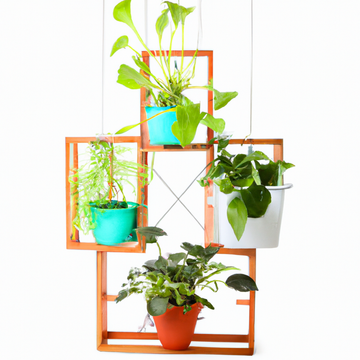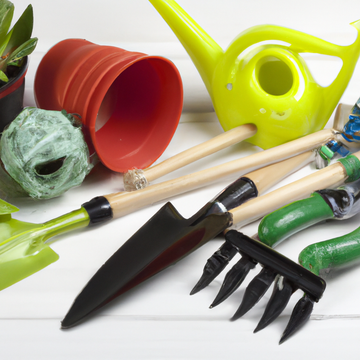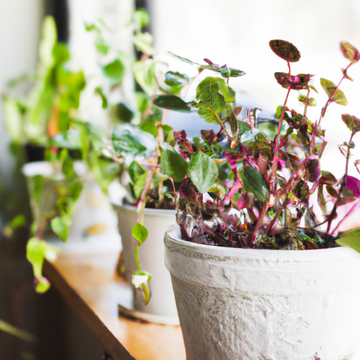Gardening Blog
How to Water Your Plants Like a Pro- The Ultimate Guide
by GOLDDUST- Rethink&Revive on May 15, 2023

Are you a plant lover but struggle to keep your green friends alive? One of the most crucial aspects of plant care is watering. However, it's not just a matter of pouring water onto the soil whenever you remember to do so. Different plants have different watering needs, and understanding how much and how often to water can make all the difference in keeping them healthy and thriving. In this blog post, we'll dive into everything you need to know about watering your plants, including tips on identifying when they need more hydration or less. So grab your trusty watering can and let's get started!
Why do plants need water?
Plants need water for a variety of reasons, and one of the most important is photosynthesis. This process allows plants to convert sunlight into energy, which they need to grow and thrive. Water plays an essential role in this process as it helps transport nutrients from the soil up through the plant's stems and leaves.
Additionally, water helps regulate a plant's temperature by providing evaporative cooling. As water molecules evaporate from a plant's leaves, heat is removed from their surfaces, keeping them from overheating and getting damaged.
Water also acts as a solvent that dissolves minerals and other nutrients present in the soil so that plants can absorb them more readily. Without enough water, these nutrients would not be able to make their way into the roots of plants.
Watering your plants regularly ensures that they have enough moisture to carry out vital processes such as photosynthesis while also preventing dehydration or damage caused by overheating or lack of nutrient uptake.
How much water do plants need?
Determining how much water your plants need can be tricky, as it varies depending on the type of plant and its environment. In general, most plants require about an inch of water per week. This can come from rainfall or watering, but it's important to avoid overwatering.
Overwatering can lead to root rot and other issues that can harm your plant's health. On the flip side, underwatering can cause wilting and stunted growth. It's important to find a balance that works for each individual plant.
To determine if your plants are getting enough water, you should check the soil regularly using a moisture meter or by sticking your finger in the soil up to your knuckle. If it feels dry at this depth, then it's time to water.
Remember that different types of containers may also affect how often you need to water. Plants in porous containers like terracotta pots will require more frequent watering than those in plastic pots.
Ultimately, paying attention to your plants' specific needs is key for ensuring they receive just the right amount of water for healthy growth.
How often should you water your plants?
One of the most common questions among new plant owners is how often they should water their plants. Unfortunately, there isn't a one-size-fits-all answer to this question since different types of plants have varying water requirements.
A good rule of thumb is to stick your finger about an inch into the soil. If it feels dry, then it's time to water your plant. However, if the soil feels moist or wet, then you can wait a bit longer before watering.
Another factor that affects how often you should water your plants is the environment in which they're placed. Plants in hot and dry climates may need more frequent watering than those in cooler and more humid environments.
You'll also want to take note of the size of your pot and drainage holes. Smaller pots with fewer drainage holes will require more frequent watering compared to larger pots with ample drainage.
It's best to do some research on the specific type of plant you have and its unique needs for proper watering care.
What type of water is best for plants?
When it comes to watering your plants, the type of water you use can actually make a difference. Ideally, you should be using clean and fresh water that is free from any contaminants or harsh chemicals.
Tap water is generally safe for most indoor plants, but if your tap water has high levels of minerals or chlorine, it may not be the best choice. In this case, consider using filtered or distilled water instead.
Another option is rainwater, which is naturally soft and devoid of any additives. However, collecting rainwater requires some effort and may not always be practical.
If you have access to well water, it's important to test it first before using it on your plants as the pH levels and mineral content can vary depending on where you live.
Regardless of what type of water you choose to use on your plants, always avoid extremes in temperature as sudden changes in temperature (hot or cold) can shock the plant's roots leading to damage or death.
How to tell if a plant needs more water ?
One of the most important factors in keeping your plants healthy is determining when they need water. Overwatering or underwatering can lead to serious damage or even death for your plant. So, how do you know when it's time to give them a drink?
First, check the soil moisture level by sticking your finger about an inch into the soil. If it feels dry, then it's time to water. However, if it still feels moist, hold off on watering for a little while longer.
Another way to tell if a plant needs more water is by its leaves. Droopy or wilted leaves that aren't caused by direct sunlight are usually a sign of dehydration and indicate that the plant needs more water.
On the other hand, some plants have developed certain adaptations to conserve water and might not show obvious signs of thirst until they're severely dehydrated. In these cases, you can test their hydration levels with a moisture meter that measures soil moisture content.
In summary, checking soil moisture levels and observing leaf droopiness are great ways to determine if your plants need more water. Don't wait until they're visibly thirsty before giving them some love!
Signs of overwatering
Overwatering your plants can be just as harmful as not watering them enough. It's important to keep an eye out for signs that your plant may be getting too much water.
One of the most obvious signs of overwatering is yellowing leaves. When a plant is over-watered, its roots become saturated and cannot absorb oxygen properly. This results in yellow or brown spots on the leaves, which eventually turn yellow and fall off.
Another sign of overwatering is wilting. While it may seem counterintuitive, when a plant gets too much water, it can't absorb nutrients properly and will start to wilt even though the soil is wet.
Mold growth on the soil surface or around the base of your plant can also indicate overwatering. The excess moisture creates a breeding ground for mold spores, which can quickly spread if left unchecked.
If you notice any of these signs in your plants, it's important to adjust their watering schedule accordingly. Remember that different types of plants have different needs when it comes to water – some prefer moist soil while others prefer drier conditions. By paying attention to your plants' individual needs, you'll help ensure they stay healthy and happy for years to come!
Conclusion
Proper watering is an essential aspect of plant care that should not be overlooked. By understanding how much water your plants need, the type of water they prefer, and how to recognize when they need more or less water, you can help them thrive and enjoy a beautiful green space.
The good news is that with a little bit of practice and observation, anyone can learn how to water their plants effectively. Remember always to use well-draining soil, provide adequate drainage holes for excess water to escape, and pay attention to the specific needs of each plant in your care.
By following these simple tips and tricks detailed in this article along with using a high-quality watering can will ensure healthy happy plants throughout every season! Happy gardening!
Why do plants need water?
Plants need water for a variety of reasons, and one of the most important is photosynthesis. This process allows plants to convert sunlight into energy, which they need to grow and thrive. Water plays an essential role in this process as it helps transport nutrients from the soil up through the plant's stems and leaves.
Additionally, water helps regulate a plant's temperature by providing evaporative cooling. As water molecules evaporate from a plant's leaves, heat is removed from their surfaces, keeping them from overheating and getting damaged.
Water also acts as a solvent that dissolves minerals and other nutrients present in the soil so that plants can absorb them more readily. Without enough water, these nutrients would not be able to make their way into the roots of plants.
Watering your plants regularly ensures that they have enough moisture to carry out vital processes such as photosynthesis while also preventing dehydration or damage caused by overheating or lack of nutrient uptake.
How much water do plants need?
Determining how much water your plants need can be tricky, as it varies depending on the type of plant and its environment. In general, most plants require about an inch of water per week. This can come from rainfall or watering, but it's important to avoid overwatering.
Overwatering can lead to root rot and other issues that can harm your plant's health. On the flip side, underwatering can cause wilting and stunted growth. It's important to find a balance that works for each individual plant.
To determine if your plants are getting enough water, you should check the soil regularly using a moisture meter or by sticking your finger in the soil up to your knuckle. If it feels dry at this depth, then it's time to water.
Remember that different types of containers may also affect how often you need to water. Plants in porous containers like terracotta pots will require more frequent watering than those in plastic pots.
Ultimately, paying attention to your plants' specific needs is key for ensuring they receive just the right amount of water for healthy growth.
How often should you water your plants?
One of the most common questions among new plant owners is how often they should water their plants. Unfortunately, there isn't a one-size-fits-all answer to this question since different types of plants have varying water requirements.
A good rule of thumb is to stick your finger about an inch into the soil. If it feels dry, then it's time to water your plant. However, if the soil feels moist or wet, then you can wait a bit longer before watering.
Another factor that affects how often you should water your plants is the environment in which they're placed. Plants in hot and dry climates may need more frequent watering than those in cooler and more humid environments.
You'll also want to take note of the size of your pot and drainage holes. Smaller pots with fewer drainage holes will require more frequent watering compared to larger pots with ample drainage.
It's best to do some research on the specific type of plant you have and its unique needs for proper watering care.
What type of water is best for plants?
When it comes to watering your plants, the type of water you use can actually make a difference. Ideally, you should be using clean and fresh water that is free from any contaminants or harsh chemicals.
Tap water is generally safe for most indoor plants, but if your tap water has high levels of minerals or chlorine, it may not be the best choice. In this case, consider using filtered or distilled water instead.
Another option is rainwater, which is naturally soft and devoid of any additives. However, collecting rainwater requires some effort and may not always be practical.
If you have access to well water, it's important to test it first before using it on your plants as the pH levels and mineral content can vary depending on where you live.
Regardless of what type of water you choose to use on your plants, always avoid extremes in temperature as sudden changes in temperature (hot or cold) can shock the plant's roots leading to damage or death.
How to tell if a plant needs more water ?
One of the most important factors in keeping your plants healthy is determining when they need water. Overwatering or underwatering can lead to serious damage or even death for your plant. So, how do you know when it's time to give them a drink?
First, check the soil moisture level by sticking your finger about an inch into the soil. If it feels dry, then it's time to water. However, if it still feels moist, hold off on watering for a little while longer.
Another way to tell if a plant needs more water is by its leaves. Droopy or wilted leaves that aren't caused by direct sunlight are usually a sign of dehydration and indicate that the plant needs more water.
On the other hand, some plants have developed certain adaptations to conserve water and might not show obvious signs of thirst until they're severely dehydrated. In these cases, you can test their hydration levels with a moisture meter that measures soil moisture content.
In summary, checking soil moisture levels and observing leaf droopiness are great ways to determine if your plants need more water. Don't wait until they're visibly thirsty before giving them some love!
Signs of overwatering
Overwatering your plants can be just as harmful as not watering them enough. It's important to keep an eye out for signs that your plant may be getting too much water.
One of the most obvious signs of overwatering is yellowing leaves. When a plant is over-watered, its roots become saturated and cannot absorb oxygen properly. This results in yellow or brown spots on the leaves, which eventually turn yellow and fall off.
Another sign of overwatering is wilting. While it may seem counterintuitive, when a plant gets too much water, it can't absorb nutrients properly and will start to wilt even though the soil is wet.
Mold growth on the soil surface or around the base of your plant can also indicate overwatering. The excess moisture creates a breeding ground for mold spores, which can quickly spread if left unchecked.
If you notice any of these signs in your plants, it's important to adjust their watering schedule accordingly. Remember that different types of plants have different needs when it comes to water – some prefer moist soil while others prefer drier conditions. By paying attention to your plants' individual needs, you'll help ensure they stay healthy and happy for years to come!
Conclusion
Proper watering is an essential aspect of plant care that should not be overlooked. By understanding how much water your plants need, the type of water they prefer, and how to recognize when they need more or less water, you can help them thrive and enjoy a beautiful green space.
The good news is that with a little bit of practice and observation, anyone can learn how to water their plants effectively. Remember always to use well-draining soil, provide adequate drainage holes for excess water to escape, and pay attention to the specific needs of each plant in your care.
By following these simple tips and tricks detailed in this article along with using a high-quality watering can will ensure healthy happy plants throughout every season! Happy gardening!
Tags:




